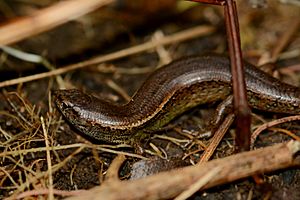Copper skink facts for kids
Quick facts for kids Copper skink |
|
|---|---|
 |
|
| Scientific classification | |
| Genus: |
Oligosoma
|
| Species: |
aeneum
|
| Synonyms | |
|
Cyclodina aenea |
|
The copper skink (Oligosoma aeneum) is a small lizard. It is a type of skink found only in the North Island of New Zealand. It belongs to the skink family, called Scincidae.
Contents
About the Copper Skink
Scientists are still learning about all the different types of skinks in New Zealand. There are thought to be between 50 and 60 species. In 2008, the copper skink was given its scientific name, Cyclodina aenea. This helped scientists understand that it was different from other similar skinks.
What Does a Copper Skink Look Like?
The copper skink is the smallest native skink in New Zealand. It grows to about 120mm long (that's about 4.7 inches). Like most skinks, it has smooth skin and a long body. It also has short legs. Its tail is quite long and gets thinner towards the end.
A cool trick copper skinks can do is drop their tail! This is called caudal autotomy. If a predator grabs its tail, the skink can break it off. This helps the skink escape. Later, a new tail will grow back. Copper skinks have small heads and round eyes that can blink.
Where Do Copper Skinks Live and What Do They Eat?
Copper skinks can live in many places. You might find them in forests or even in city gardens. They mostly eat small insects and other tiny creatures.
Copper skinks are viviparous. This means they give birth to live young, not eggs. They mate in spring. Then, in late summer, they have about 3 to 7 babies.
Copper Skinks in New Zealand
It's a bit of a mystery how copper skinks first arrived in New Zealand. Scientists think they have been part of New Zealand's wildlife for millions of years. This long time allowed many different skink types to develop.
One study in 2009 suggested that all native New Zealand skinks came from one ancestor. This ancestor might have arrived during the early Miocene era. It may have floated to New Zealand on bits of wood or plants from New Caledonia. From this first arrival, skinks spread out. They adapted to different places and became the many species we see today.
Protecting Copper Skinks
Even though humans have changed New Zealand's landscape a lot, copper skinks have done well. They have adapted to living in cities. In 2012, the Department of Conservation (DOC) said the copper skink was "Not Threatened." This means they are not currently in danger.
You can often see them in gardens in Auckland. This is because they can live in many different small habitats. In the 1980s, some copper skinks were moved to a park in Rotorua. Even with many cats around, their babies are still found there today. This shows that moving these skinks to city gardens can work!
However, some animals brought to New Zealand can be a problem. Cats, rats, and hedgehogs eat skinks. These predators can lower skink numbers in some areas.
Competition with Rainbow Skinks
Another concern is the rainbow skink (Lampropholis delicata). This skink was brought to New Zealand. It is very good at having many babies. Rainbow skinks live in similar places and eat similar food as copper skinks. This means they might compete for food and space.
Scientists are still studying how rainbow skinks affect copper skinks. One study in 2004 looked at copper and rainbow skinks kept together. It didn't find big differences in their health. But because they need the same things to live, many people still worry. They think rainbow skinks could be a threat to copper skink populations.

